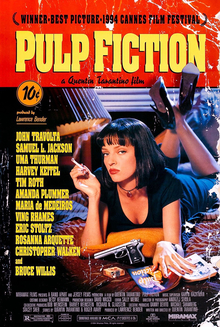
Pulp Fiction is a 1994 American independent crime film written and directed by Quentin Tarantino from a story he conceived with Roger Avary. It tells four intertwining tales of crime and violence in Los Angeles, California. The film stars John Travolta, Samuel L. Jackson, Bruce Willis, Tim Roth, Ving Rhames, and Uma Thurman. The title refers to the pulp magazines and hardboiled crime novels popular during the mid-20th century, known for their graphic violence and punchy dialogue.

The Jealous God is a novel by John Braine which was first published in 1964. Set in the early 1960s among the Irish Catholic community in a small Yorkshire town, the book is about a 30-year-old man and his attempts at liberating himself from his domineering mother. The title refers to the latter's wish that her "favourite" son, although already rather old, become a clergyman. It was adapted into a film in 2005.

Crime films, in the broadest sense, is a film genre inspired by and analogous to the crime fiction literary genre. Films of this genre generally involve various aspects of crime and its detection. Stylistically, the genre may overlap and combine with many other genres, such as drama or gangster film, but also include comedy, and, in turn, is divided into many sub-genres, such as mystery, suspense or noir.
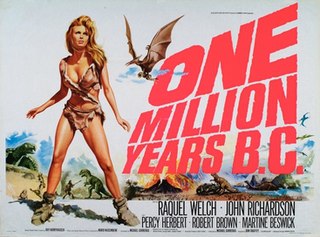
One Million Years B.C. is a 1966 British adventure fantasy film directed by Don Chaffey. The film was produced by Hammer Film Productions and Seven Arts, and is a remake of the 1940 American fantasy film One Million B.C.. The film stars Raquel Welch and John Richardson, set in a fictional age of cavemen and dinosaurs coexisting together. Location scenes were filmed on the Canary Islands in the middle of winter, in late 1965. The UK release prints of this film were printed in dye transfer Technicolor. The U.S. version released by 20th Century Fox was cut by nine minutes, printed in DeLuxe Color, and released in 1967.
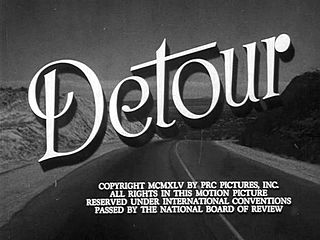
A road movie is a film genre in which the main characters leave home on a road trip, typically altering the perspective from their everyday lives. Road movies often depict travel in the hinterlands, with the films exploring the theme of alienation and examining the tensions and issues of the cultural identity of a nation or historical period; this is all often enmeshed in a mood of actual or potential menace, lawlessness, and violence, a "distinctly existential air" and is populated by restless, "frustrated, often desperate characters". The setting includes not just the close confines of the car as it moves on highways and roads, but also booths in diners and rooms in roadside motels, all of which helps to create intimacy and tension between the characters. Road movies tend to focus on the theme of masculinity, some type of rebellion, car culture, and self-discovery. The core theme of road movies is "rebellion against conservative social norms".
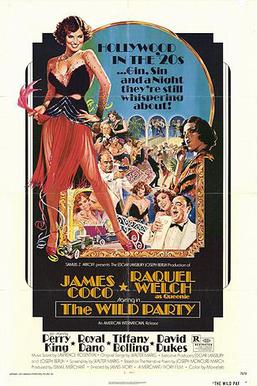
The Wild Party is a 1975 American comedy-drama film directed by James Ivory and produced by Ismail Merchant for Merchant Ivory Productions. Loosely based on Joseph Moncure March's narrative poem of the same name, the screenplay is written by Walter Marks, who also composed the score. The plot follows an aging silent movie comic star of the 1920s named Jolly Grimm attempts a comeback by staging a party to show his new film.

Bradford Dillman was an American actor and author.
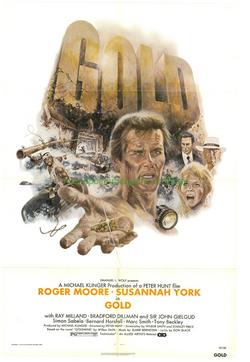
Gold is a 1974 British thriller film starring Roger Moore and Susannah York and directed by Peter R. Hunt. It was based on the 1970 novel Gold Mine by Wilbur Smith. Moore plays Rodney "Rod" Slater, general manager of a South African gold mine, who is instructed by his boss Steyner to break through an underground dike into what he is told is a rich seam of gold. Meanwhile, he falls in love with Steyner's wife Terry, played by York. In the United States, the film was released only as part of a double bill with The Taking of Pelham One Two Three.

The beach party film is an American film genre of feature films which were produced and released between 1963 and 1968, created by American International Pictures (AIP), beginning with their surprise hit, Beach Party, in July 1963. With this film, AIP is credited with creating the genre. In addition to the AIP films, several contributions to the genre were produced and released by major and independent studios alike. According to various sources, the genre comprises over 30 films, with the lower-budget AIP films being the most profitable.

The French Lieutenant's Woman is a 1981 British romantic drama film directed by Karel Reisz, produced by Leon Clore, and adapted by the playwright Harold Pinter. It is based on The French Lieutenant's Woman, a 1969 novel by John Fowles. The music score is by Carl Davis and the cinematography by Freddie Francis.
Jason Scott Merrells is an English actor, who is best known for his roles in Casualty, Queer as Folk, Cutting It, Waterloo Road and Emmerdale.
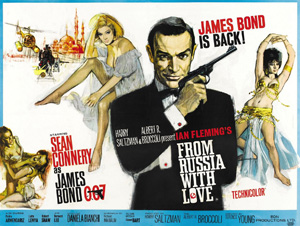
From Russia with Love is a 1963 spy film and the second in the James Bond series produced by Eon Productions, as well as Sean Connery's second role as MI6 agent 007 James Bond.
Cinema Retro is an English magazine devoted to "celebrating films of the 1960s & 1970s". Founded in 2005 by Lee Pfeiffer and Dave Worrall, it is subtitled "the Essential Guide to Cult and Classic Movies". The 64-page full-colour magazine is published three times a year with a wide range of rare or previously unseen press photographs.

Basil Gogos was an American illustrator best known for his portraits of movie monsters which appeared on the covers of Famous Monsters of Filmland magazine in the 1960s and 1970s.
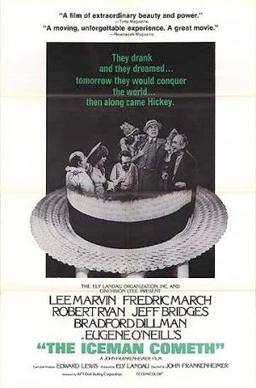
The Iceman Cometh is a 1973 American drama film directed by John Frankenheimer. The screenplay, written by Thomas Quinn Curtiss, is based on Eugene O'Neill's 1946 play of the same name. The film was produced by Ely Landau for the American Film Theatre, which from 1973 to 1975 presented thirteen film adaptations of noted plays.

Scream and Scream Again is a 1970 British horror film starring Vincent Price, Christopher Lee, Alfred Marks, Michael Gothard, and Peter Cushing. It is based on the novel The Disorientated Man (1967) attributed to 'Peter Saxon', a house pseudonym used by various authors in the 1960s and 1970s.

Between Two Women is a 2000 historical film by British writer-director Steven Woodcock. It tells the story of Ellen, a factory worker's wife trapped in an unhappy marriage amidst the grime and industrial noise of northern England.
Steven Woodcock is a British film director, writer, and producer. He has made two movies set in north England, Between Two Women and The Jealous God. They are similar, being 1950s and 1960s set, and resemble each other in how they were made but they are different in tone and narrative style. Woodcock has written at least one book under his own name, the novel of Between Two Women on which he based his film screenplay.
The arthouse action genre is an emerging film genre in contemporary cinema that traces its roots back to Asian and European films. Characteristics of arthouse action films include stylized action, an arthouse atmosphere, metaphysical subtext, psychological characterisation and a disjointed, fragmented narrative with more complexity than the typical action film. These come together to create a sense of "dreamy surrealism."

Tanzania's film industry, also known as Swahiliwood or Bongo movie and Bongowood, was established around 2001.















